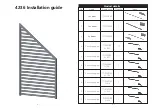
6
4:2 CONNECTING THE DISPLAY
Connect the black wire to the negative supply and the red wire to the positive
via a 1/4 amp fuse. Plug the paddle wheel unit into the socket on the
display unit.
4:3 LOG OPERATION
When switched on the display will momentarily display the total distance and
then revert to reading speed. The speed is shown in nautical miles per hour
and is reliable up to 25.0 knots. (At higher speeds cavitation around the
paddle wheel may reduce accuracy).
A short press of the SPEED key will turn the backlight on and off.
Using a proprietary brand of marine silicone sealant, apply about 2mm of
sealant around the skin fitting flange where it contacts the hull and also up the
sidewall to a distance 3mm higher than the combined thickness of the hull and
the securing nut. This will ensure there is sealant in the threads to seal the hull
and to hold the nut securely in place. The nut has a groove on its underside
which should also be filled with silicone. From the outside of the hull, push the
housing into the mounting hole using a twisting motion to squeeze out excess
sealant. With someone outside holding the skin fitting in position, from the
inside apply a 2mm thick layer of sealant around the hole equal to the
diameter of the securing nut. Carefully tighten down the nut taking care not to
over tighten it, just over finger tight is enough.
Carefully remove all surplus sealant from the inside and outside of the hull and
leave until the sealant has cured. It is recommended that the area around the
skin fitting is thoroughly cleaned and the whole assembly be fibre glassed into
the hull as shown in fig 2. ensuring that the top 20mm of thread remains free of
sealant.
Figure 2 - Paddle Housing Installation (Sectioned view)
HULL
20mm
MINIMUM
SECURING
NUT
SILICONE
SEALANT
Housing
G.R.P.
42mm
Hole for paddle wheel unit
NOT TO SCALE






































